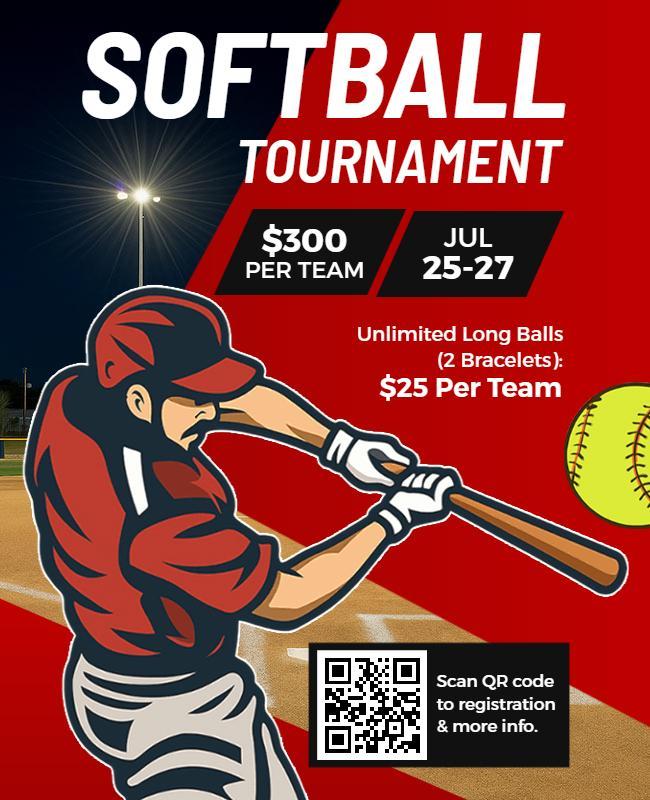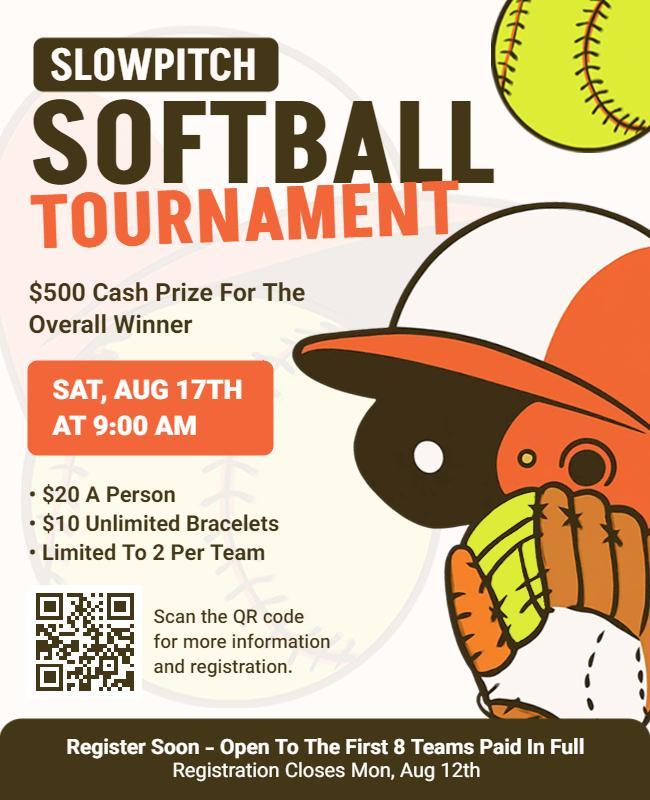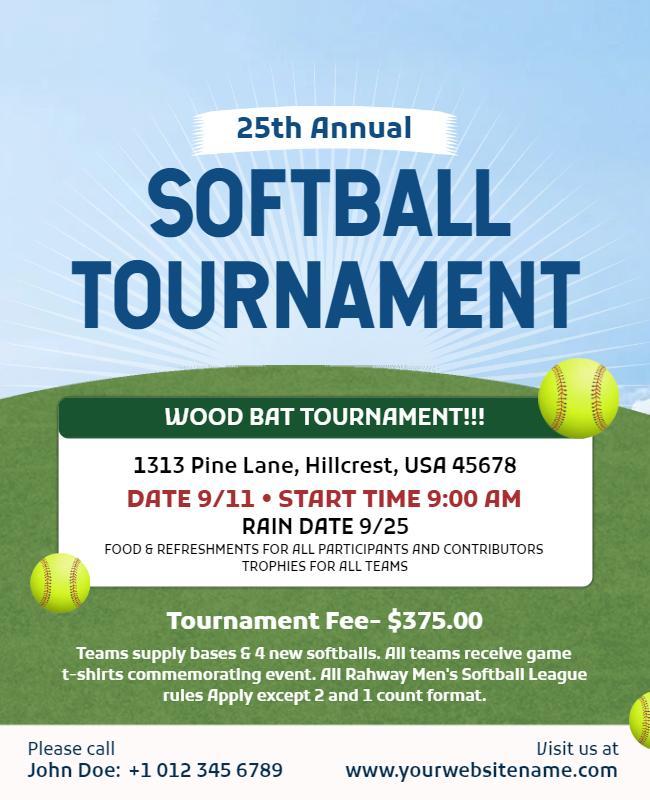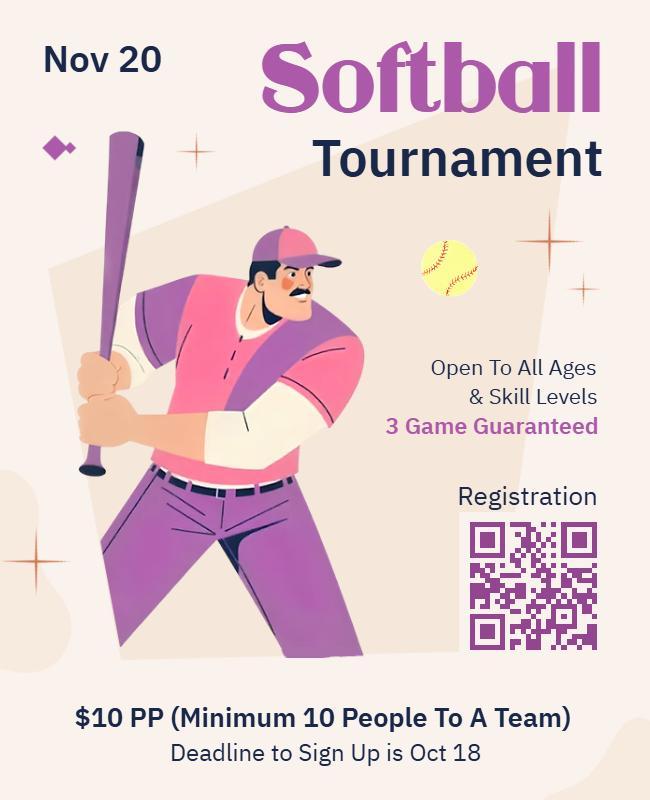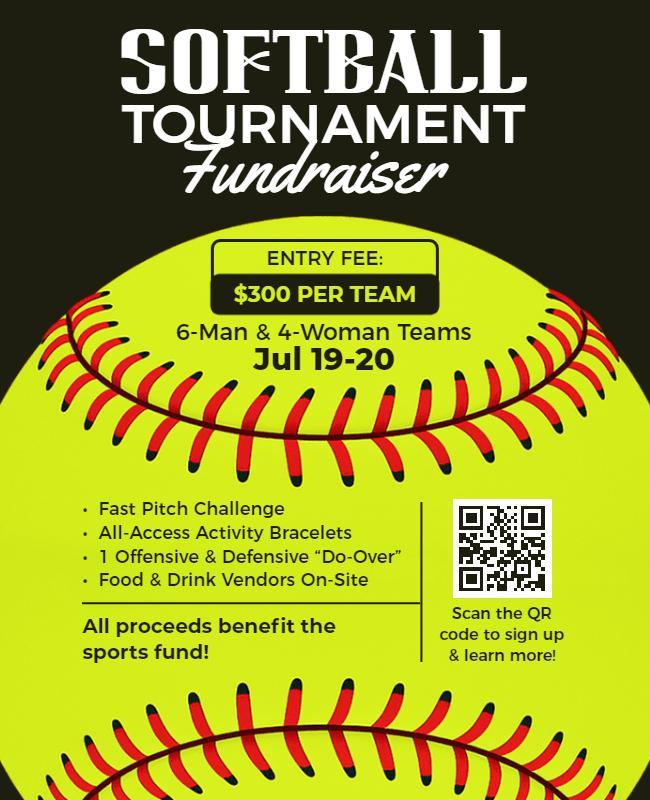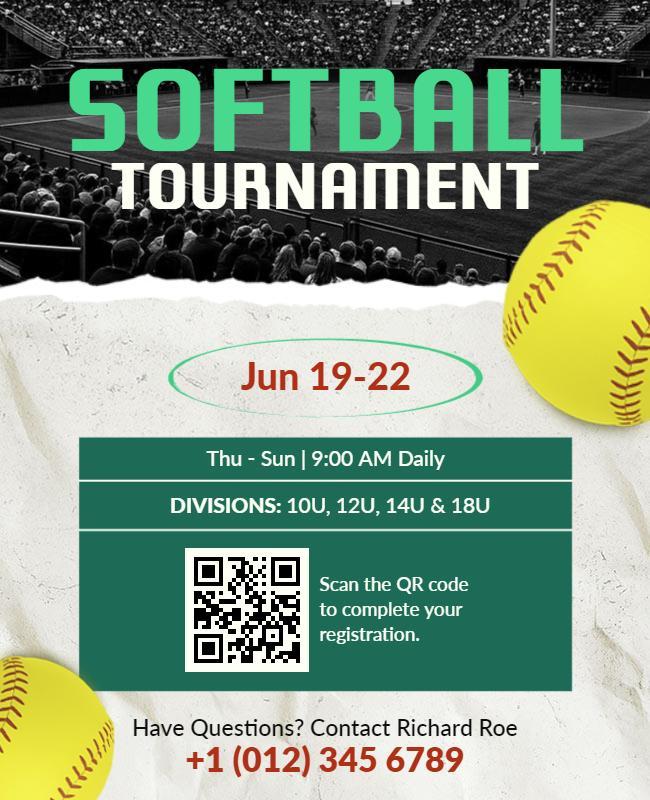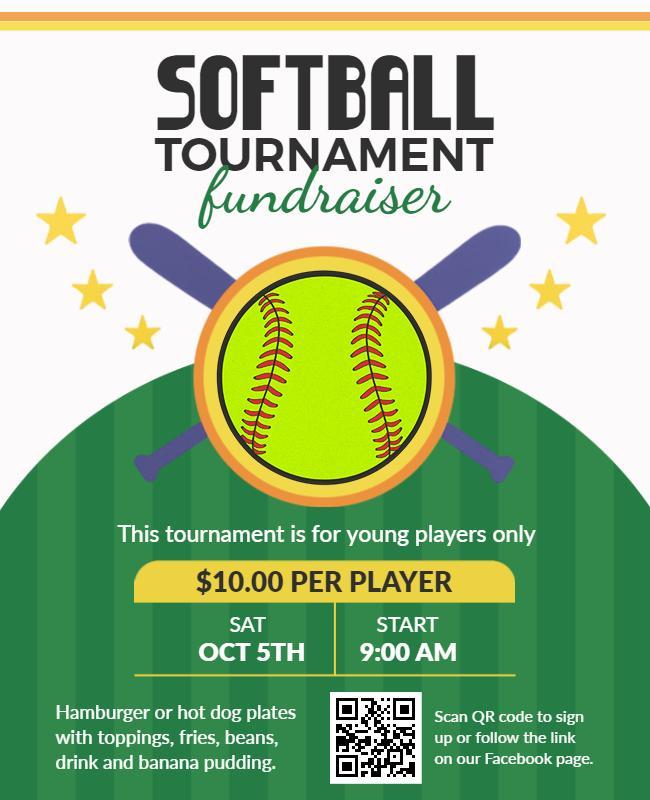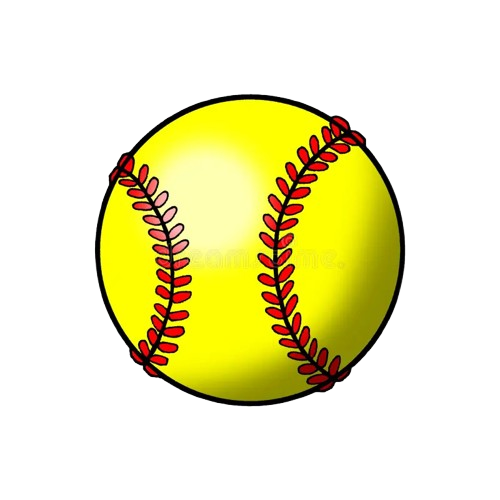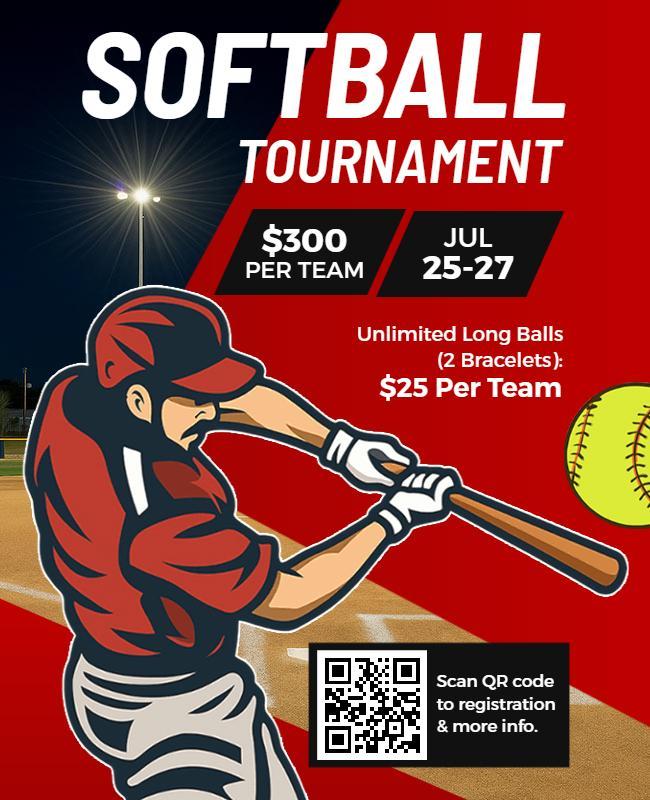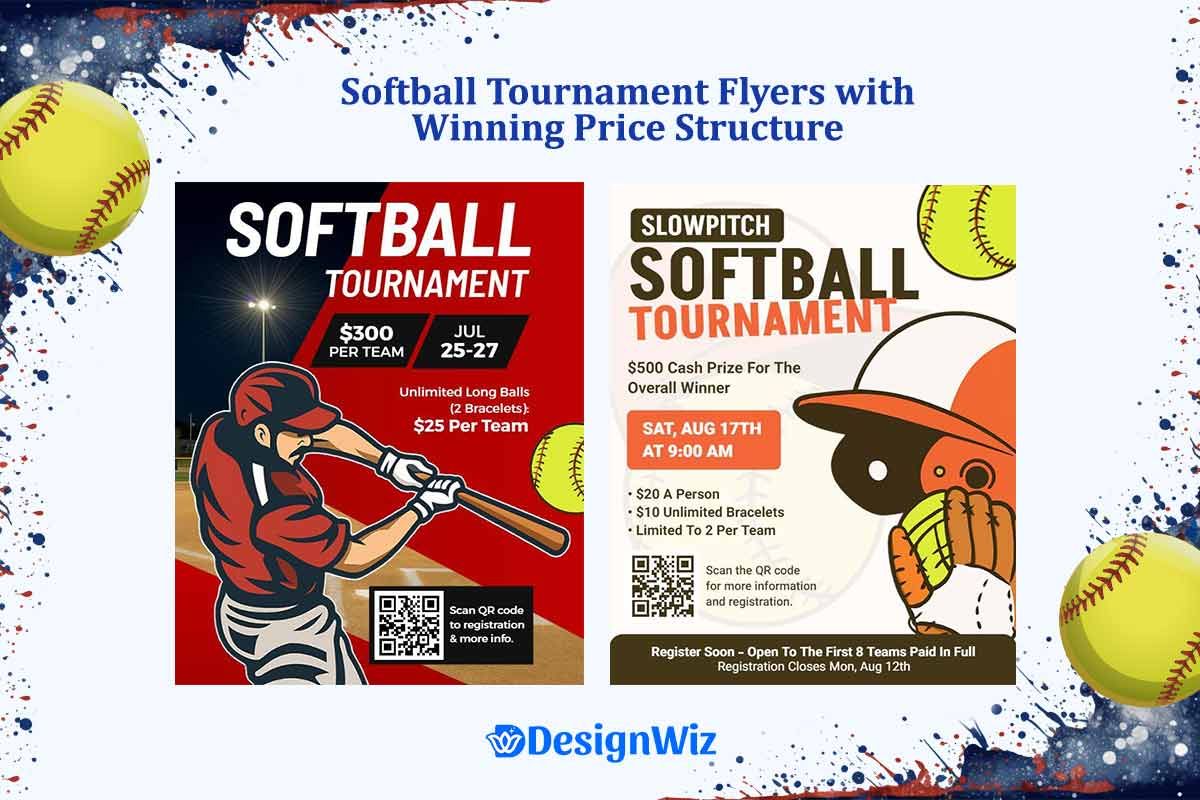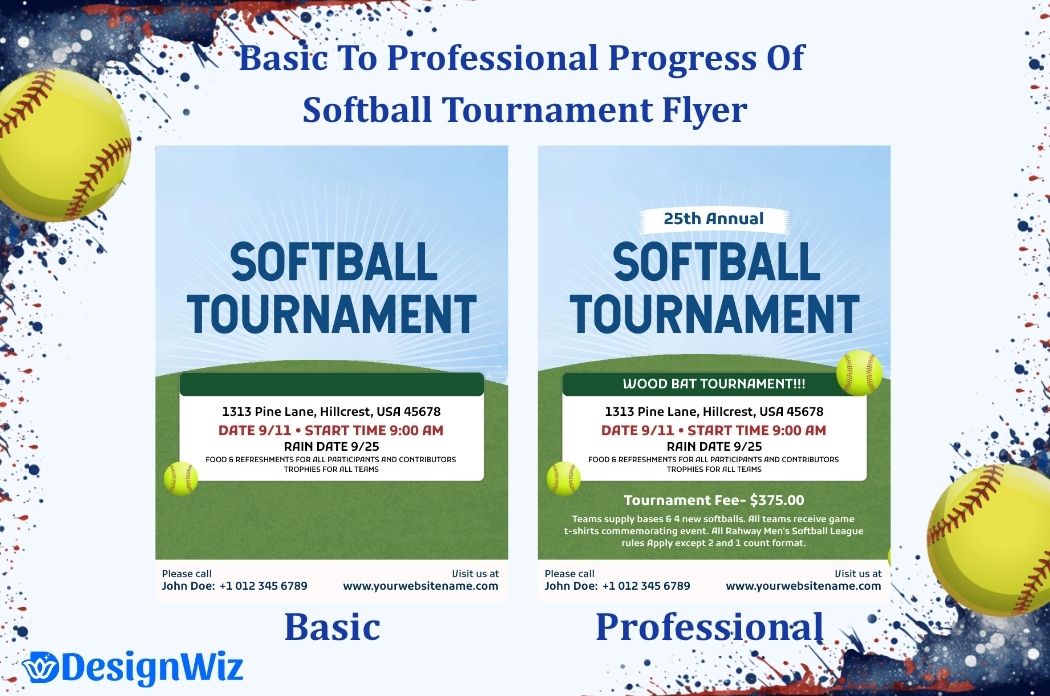Get ready-made flyer templates that set the tone—simple, exciting, and perfect for brackets, team invites, and crowds.
Tournament directors face a unique challenge: you need 16-32 teams to commit time, money, and roster spots based solely on your softball tournament flyer. Unlike camps or tryouts, where individuals make decisions, tournament registration requires team-level commitment involving coaches, parents, and sometimes entire organizations. That’s why a compelling softball tournament flyer can be your strongest tool to spark interest and build early team commitment.
The numbers tell the story. Average tournament promotion reaches 200+ teams but typically converts only 15-25% to actual registration. Top-performing tournaments achieve 40-60% conversion rates through strategic flyer design and systematic promotion approaches.
Why Tournament Flyers Fail?
Identify key reasons tournament flyers miss the mark and reduce team sign-ups.
- Information Overload Without Hierarchy: Teams need to quickly understand format, prizes, and logistics. Most failed tournaments bury essential details in dense paragraphs or scatter information randomly across the flyer.
- Unclear Competition Format: Coaches need to know exactly what they’re committing to game guarantees, tournament length, skill level expectations. Vague descriptions like “competitive tournament” provide no useful decision-making information.
- Weak Value Proposition: Generic prize structures and facility descriptions don’t differentiate your tournament from 20+ others happening the same weekend. Teams need compelling reasons to choose your event.
- Poor Registration Process Communication: Complex registration requirements, unclear deadlines, or confusing payment processes create friction that prevents team commitment even when interest exists.
How Do You Design Softball Tournament Flyers?
Effective softball flyers require understanding team decision-making psychology and addressing the specific concerns coaches face when evaluating tournament opportunities.
Step 1: Define Tournament Format and Structure
Teams must understand exactly what they’re committing to before considering other factors. Format clarity eliminates confusion and sets appropriate expectations.
Essential Format Elements:
Clarifying your tournament structure up front helps teams plan, compare, and commit this section outlines the key format details every flyer should include.
Tournament Type Specification:
- Single elimination (team elimination after one loss)
- Double elimination (team plays until two losses)
- Pool play followed by bracket play – Round-robin with championship determination
Game Guarantees and Structure:
- Minimum games per team regardless of performance
- Average games for teams reaching different levels
- Game length (time limit vs innings) – Mercy rule and timing considerations
Division Organization:
- Age group divisions with specific birth date cutoffs
- Skill level divisions (recreational, competitive, elite)
- Team capacity per division – Combined division possibilities if registration is low
Step 2: Create Competition Value Proposition
Teams choose tournaments based on perceived value relative to time, cost, and effort invested. Your value proposition must differentiate your event from alternatives.
Competitive Advantage Elements:
Highlighting what sets your tournament apart can drive registrations this section covers the features that enhance credibility, competition, and the overall experience.
Facility and Organization Quality:
- Professional field conditions and maintenance
- Multiple diamond availability for efficient scheduling
- Quality umpiring and tournament management
- Spectator amenities and parking availability
Competition Level and Recognition:
- Historical participating teams and skill levels
- College recruiting presence (if applicable)
- Media coverage or special recognition
- Post-tournament rankings or seeding implications
Convenience and Experience Factors:
- Geographic accessibility for target teams
- Scheduling efficiency (minimal downtime between games)
- Family-friendly atmosphere and activities
- Concession quality and vendor variety
Step 3: Design Clear Bracket/Schedule Visualization
Complex tournament formats require visual explanation. Teams need to understand advancement paths and time commitments before registering.
Bracket Communication Strategies:
- Format Diagrams: Simple visual representations showing how teams advance through rounds. Include game numbers and estimated timing for planning purposes.
- Schedule Templates: Example schedules showing typical game timing and flow. Help teams understand tournament duration and intensity.
- Capacity Planning: Clear indication of team limits per division and total tournament capacity. Create urgency through scarcity when appropriate.
Step 4: Structure Registration Process
Streamlined registration removes barriers between interest and commitment. Complex processes lose teams to competitors with simpler requirements.
Registration Optimization Elements:
Ensure teams register on time and arrive prepared by clearly outlining all requirements, deadlines, and communication steps.
Clear Deadlines and Consequences:
- Early bird registration deadline with cost savings
- Final registration deadline with late fees
- Team confirmation requirements and timing
- Refund policies and withdrawal procedures
Simple Requirements Communication:
- Team roster submission format and deadline
- Age verification documentation needed
- Insurance and liability requirement explanations
- Payment methods and installment options
Confirmation and Communication Process: –
- Registration confirmation timeline and method
- Tournament information distribution schedule
- Contact information for questions and issues
- Emergency communication procedures
Step 5: Integrate Sponsor Recognition
Sponsor integration must balance recognition obligations with flyer clarity and effectiveness.
Sponsor Integration Strategies:
Present sponsor details clearly and professionally without distracting from your tournament message.
Tiered Recognition System:
- Title sponsor prominence without overwhelming content
- Supporting sponsor acknowledgment in designated areas
- In-kind sponsor recognition for services provided
- Future sponsorship opportunity promotion
Visual Balance Maintenance:
- Sponsor areas that complement rather than compete with content
- Professional logo reproduction and sizing
- Color coordination with overall design scheme
- Clear separation between sponsored and tournament content
Step 6: Optimize for Team Decision-Makers
Tournament registration involves multiple stakeholders with different priorities and concerns.
Decision-Maker Considerations:
- Coach Priorities: Competition level, tournament reputation, scheduling efficiency, prize value
- Parent Priorities: Cost, location convenience, spectator experience, safety considerations
- Organization Priorities: Budget impact, scheduling conflicts, player development value, community representation
Read More: Complete Guide to Softball Flyer Design: Expert Tips & Best Practices 2025
What Information Should Softball Tournament Flyers Include?
Tournament flyers must communicate complex information clearly while maintaining visual appeal and professional credibility.
Essential Tournament Details
Provide all critical tournament details upfront to help teams assess fit, plan logistics, and ensure eligibility.
Competition Format Specification:
Outline these core tournament logistics to ensure transparency, smooth scheduling, and proper team qualification.
Tournament Structure:
- Bracket type with advancement explanation
- Number of teams per division and total capacity
- Game timing (7 innings, 90 minutes, etc.)
- Tiebreaker procedures and advancement criteria
Division and Eligibility Requirements:
- Age groups with birth date cutoff specifications
- Skill level divisions with clear descriptions
- Team roster size limits and player eligibility
- Proof of age requirements and verification process
Schedule and Timing Information:
- Tournament dates with start and end times
- Estimated game schedules for planning purposes
- Weather contingency plans and makeup procedures
- Awards ceremony timing and requirements
Prize and Recognition Structure
List all awards, recognitions, and participation benefits to set clear expectations for teams and players.
Championship Awards:
- Trophy specifications for each division champion
- Runner-up recognition and awards
- Team photo opportunities and presentation ceremony
- Championship banner or recognition display
Individual Recognition:
- MVP awards for each division
- All-tournament team selection process
- Sportsmanship awards and criteria
- Special skill recognition (pitching, batting, defense)
Participation Value:
- Participation certificates or medals for all players
- Team photo opportunities at professional backdrop
- Tournament program inclusion and team listings
- Social media coverage and photo sharing
Logistics and Facility Information
Provide essential venue and safety information to ensure a smooth, comfortable experience for teams, families, and spectators.
Venue Details:
- Complete facility address with landmark references
- Parking availability and overflow arrangements
- Field specifications and number of diamonds available
- Dugout and spectator seating arrangements
Spectator and Family Information:
- Concession stand availability and menu highlights
- Restroom and water fountain locations
- Shade and weather protection options
- Photography and video recording policies
Emergency and Safety Procedures:
- First aid availability and emergency contact information
- Weather delay and cancellation communication methods
- Lost and found procedures and contact information
- Security presence and emergency evacuation plans
According to research by Tom Farrey, real progress in youth sports depends on connecting grassroots leadership with organizational support. Evidence-based practices and community collaboration are essential for improving program quality and accessibility.1
Read More: Softball Camp Flyer Design Guide: Attract More Participants This Season
What Do Experts Recommend for Softball Tournament Flyers?
Tournament management professionals and successful organizers share common approaches to effective tournament promotion.
Tournament Director Best Practices
- Team Capacity Planning: Successful tournaments plan for 20-30% more inquiries than available spots, creating natural urgency and selection pressure that increases registration commitment rates.
- Registration Timeline Optimization: The most effective promotion schedule includes early bird incentives 8-10 weeks out, regular promotion 6-8 weeks out, urgency messaging 4 weeks out, and waitlist management 2 weeks out.
- Communication Strategy: Professional tournaments maintain regular communication with registered teams, providing updates on bracket development, schedule changes, and tournament preparation information.
- Sponsor Integration: Top-performing tournaments treat sponsors as partners rather than just revenue sources, providing value beyond logo placement through social media promotion, vendor opportunities, and community recognition.
Successful Tournament Promotion Case Studies
Real-world examples show how strategic flyer design and messaging drive tournament turnout, loyalty, and reputation.
Case Study 1: Metro Youth Championship
- Challenge: New tournament competing against established events
- Solution: Emphasized superior facility quality and college recruitment presence
- Results: 128% of target registration in first year, waitlist created
- Key Elements: Professional photography of facilities, testimonials from college coaches, clear competitive level communication
Study 2: Community Pride Tournament
- Challenge: Limited budget for prizes competing against major sponsored events
- Solution: Focused on family experience, community involvement, and participant recognition
- Results: 89% repeat team registration rate, 45% growth over three years
- Key Elements: Family-friendly scheduling, local business partnerships, extensive participant recognition
Case Study 3: Elite Skills Showcase
- Challenge: Attracting top-level teams willing to travel significant distances
- Solution: Premium facility presentation, significant prize structure, recruitment opportunity emphasis
- Results: 67% of teams traveled over 100 miles, college recruitment presence doubled
- Key Elements: Professional facility photography, scholarship opportunity data, past participant success stories
According to research from the University of Pennsylvania Wharton School, emphasizing superior facility quality and recruitment presence creates competitive advantages for new tournaments entering established markets.2
Industry Standards and Benchmarks
Understand how your tournament promotion stacks up by comparing it to industry benchmarks for registration and timing.
Registration Rate Expectations:
- Youth recreational tournaments: 25-35% conversion from inquiry to registration
- Competitive tournaments: 35-45% conversion with proper positioning
- Elite/showcase tournaments: 45-60% conversion when targeting appropriate teams
Promotion Timeline Standards:
- 12 weeks: Save-the-date announcements to previous participants
- 8-10 weeks: Full promotion launch with early bird incentives
- 6 weeks: Main promotion push through leagues and associations
- 4 weeks: Urgency messaging and capacity updates
- 2 weeks: Final registration push and waitlist management
What’s the Easiest Way to Create Professional Softball Tournament Flyers?
Tournament flyer creation can be streamlined through strategic template use and systematic content organization.
Template-Based Approach
Use flexible, professional templates to streamline flyer creation across formats while meeting your tournament’s unique branding and communication needs.
Template Selection Criteria:
- Tournament-specific layouts with bracket visualization areas
- Sponsor integration zones that don’t compromise content clarity
- Professional color schemes that convey credibility and organization
- Multi-format adaptability for print, digital, and social media distribution
Customization for Tournament Needs:
- Brand integration with consistent color and logo usage
- Sponsor placement according to contribution and recognition levels
- Content adaptation for specific tournament format and divisions
- Contact information and registration process customization
Multi-Format Output Planning:
- Print formats for facility posting and coach distribution
- Digital formats optimized for email and website distribution
- Social media formats for Facebook, Instagram, and Twitter sharing
- Mobile-optimized versions for smartphone viewing and sharing
Design Tools and Resources
Choose from free tools, pro software, or ready-made templates to create polished, tournament-ready flyers without starting from scratch.
Free Options:
- DesignWiz: Softball Tournament templates with drag-and-drop customization
- PowerPoint: Professional layouts with custom bracket creation
- Google Slides: Collaborative design with team input and approval
- GIMP: Advanced editing for custom graphics and sponsor integration
Professional Tools:
- Specialized Tournament Software: Bracket integration with promotional materials
- Professional Design Services: Custom creation for major tournaments
Template Marketplaces:
- Sports-specific template collections with tournament focus
- Customizable designs with brand integration capabilities
- Professional quality at fraction of custom design cost
following Northwestern University’s research showing that easy-to-read bullet points can be more powerful than long sentences and paragraphs.3
Time-Saving Strategies
Save hours on design and distribution by reusing core elements and integrating registration tools directly into your flyers.
Reusable Design Elements:
- Master template creation for annual tournament series
- Sponsor logo library with proper sizing and formatting
- Standard text blocks for common information sections
- Color palette and font selection for brand consistency
Automated Registration Integration:
- QR codes linking directly to registration forms
- Online registration system embedding in digital formats
- Social media sharing optimization with registration links
- Email campaign integration with flyer distribution
Read More: How to Create Softball Fundraiser Flyers That Drive Results
How Do You Promote Softball Tournaments Effectively?
Tournament promotion success depends on reaching decision-makers through appropriate channels with compelling messaging at optimal timing.
Multi-Channel Distribution Strategy
Reach more teams and families by combining league networks, community partnerships, and digital channels for broad, effective tournament promotion.
League and Association Networks:
- Official league communication channels and newsletters
- Coach and manager direct email databases
- Association website posting and social media sharing
- Regional and state organization bulletin distribution
Community and Facility Partnerships:
- Sports facility bulletin boards and coach communication
- Local business partnerships with cross-promotional opportunities
- School athletic department connections and coaching networks
- Youth sports league collaboration and reciprocal promotion
Digital Amplification Methods:
- Team and organization social media account sharing
- Email marketing campaigns to coach and parent databases
- Website SEO optimization for tournament-related searches
- Online registration platform promotion and partner networks
Timeline and Sequencing Strategy
- 12 Weeks Out: Save-the-date announcements to previous participants and target team databases
- 8-10 Weeks: Full promotion launch with complete tournament information and early bird incentives
- 6 Weeks: Early bird deadline emphasis and major promotional push through all channels
- 4 Weeks: Final registration deadline approach with urgency messaging and capacity updates
- 2 Weeks: Waitlist management and final detail communication to registered teams
Registration Conversion Optimization
Boost signups and team retention by streamlining follow-ups, simplifying registration, and rewarding early and returning participants.
Inquiry to Registration Process:
- Immediate response to tournament inquiries with complete information packets
- Follow-up communication sequence for teams expressing initial interest
- Personal contact from tournament directors for major team commitments
- Simplified registration process with multiple payment and submission options
Team Retention Strategies:
- Regular updates on tournament development and registered team quality
- Early bracket release for planning purposes when possible
- Special recognition for returning teams and early commitments
- Referral incentives for teams bringing additional participants
According to the University of Kansas School of Education, data-driven personalization allows sports organizations to enhance fan engagement and foster brand loyalty through targeted campaigns.4
Read More: Softball Tryout Flyer Design: Attract the Best Players
Softball Tournament Flyer Design Inspiration Gallery
Step up to the plate with flyer designs that hit it out of the park! Our flyer templates is packed with bold, energetic visuals crafted to bring your event to life. From gritty sandlot vibes to sleek pro-league styles, every design is made to grab attention and build excitement.
Need a flyer that sparks competitive spirit? Or maybe one that celebrates community fun? This gallery showcases diverse layouts, vibrant color schemes, and action-packed images that capture the thrill of the game. Add your tournament name, team matchups, location, and sponsors every detail fits in with ease.
- Annual Softball Tournament Event Flyer Template
- Thanksgiving Softball Tournament Event Flyer Template
- Dynamic Softball Tournament Fundraiser Event Flyer Template
- Energetic Green Softball Tournament Event Flyer Template
- Playful Cartoon Softball Tournament Event Flyer Template
- Illustrated Softball Tournament Event Flyer Template
- Dynamic Red Softball Tournament Sports Event Flyer Template
- Athletic Softball Tournament with Iconic Gear Flyer Template
- Slowpitch Softball Tournament Competition Flyer Template
These flyers are perfect for sharing across social media, printing for local spots, or emailing to teams and fans. Whether you’re hosting a youth league showdown or a charity home-run derby, you’ll find the perfect design spark right here.
FAQs About Softball Tournament Flyers
How far in advance should we promote softball tournaments?
Begin promotion 8-12 weeks before tournament dates. This timeline allows teams to plan schedules, secure players, and arrange travel while creating appropriate urgency for registration deadlines.
What’s the most important information on a tournament flyer?
Tournament format and structure clarity. Teams need to understand game guarantees, advancement procedures, and time commitments before considering other factors like prizes or location.
How do we attract teams to a new tournament?
Focus on unique value propositions: superior facilities, convenient location, attractive prize structure, or excellent organization reputation. Include testimonials from similar tournaments or organizing committee credentials.
Should tournament flyers target coaches or parents?
Primary target is coaches and team managers who make registration decisions. Include parent-appealing information about spectator amenities and family-friendly scheduling for secondary decision-maker influence.
What’s the biggest mistake in tournament flyer design?
Information hierarchy problems. Teams need to quickly understand format, prizes, cost, and registration requirements. Detailed rules and policies should be available separately, not cluttering the main promotional flyer.
How do we handle sponsor recognition without overwhelming the flyer?
Create designated sponsor recognition areas that complement rather than compete with essential tournament information. Tier recognition by contribution level and maintain visual balance.
What registration information is essential for teams?
Registration deadline, entry fee, roster requirements, age verification needs, and simple contact information for questions. Streamline the process to reduce registration friction.
How do we promote tournaments during peak season competition?
Differentiate through specific advantages: facility quality, prize structure, scheduling convenience, or organization reputation. Focus on unique value rather than generic tournament benefits.
Can we reuse tournament flyer designs for multiple events?
Template designs work well for consistency, but customize specific details like dates, locations, prizes, and registration information. Generic materials perform significantly worse than event-specific promotion.
What’s the best way to track tournament promotion effectiveness?
Use unique tracking methods for different distribution channels: specific contact information, registration codes, or source identification in registration forms. Monitor conversion rates by promotion method.
People Also Ask
How do I design a professional-looking softball tournament flyer?
Use a clean layout with clear visual hierarchy, high-quality action photos or tournament logos, consistent fonts (maximum 2-3 font families), team colors or traditional softball colors, plenty of white space, and professional formatting. Include your organization’s branding and ensure all text is easily readable from a distance.
What size should a softball tournament flyer be?
Standard sizes include 8.5″ x 11″ for posting and handouts, 11″ x 17″ for prominent display at fields and facilities, 5.5″ x 8.5″ for mailings and compact distribution. For digital use, create 1080x1080px squares for social media and 1200x630px horizontal formats for Facebook events and website headers.
How far in advance should I promote my softball tournament?
Begin promotion 6-8 weeks before the tournament to allow teams time to plan, register, and arrange travel if needed. Send save-the-dates even earlier for annual tournaments. Create a promotion timeline with early announcements, registration opening, early bird deadlines, and final registration reminders.
Conclusion
Effective softball flyers combines clear communication, compelling value propositions, and systematic distribution to consistently achieve full registration and create competitive brackets.
Tournament Success Implementation Checklist
Information Architecture:
- Tournament format clearly explained with visual aids
- Prize structure appropriately sized for competition level
- Registration process streamlined with multiple contact methods
- Logistics communicated comprehensively without overwhelming detail
Design and Presentation:
- Professional appearance that conveys quality organization
- Sponsor integration balanced with content clarity
- Multi-format optimization for various distribution methods
- Contact information prominent and easily accessible
Promotion and Distribution:
- Multi-channel distribution strategy targeting appropriate decision-makers
- Timeline optimization with early bird incentives and urgency creation
- Follow-up systems for inquiry conversion and team retention
- Performance tracking for continuous improvement
Reference
- Farrey, Tom. “10 Steps to Build a Better Youth Sport System.” Global Sport Matters, Arizona State University.
- Terwiesch, Christian, and Karl Ulrich. “How Innovation Tournaments Create Gargantuan Wins.” Knowledge@Wharton, University of Pennsylvania Wharton School, 2023.
- Northwestern University. “Best Practices for Designing Flyers: Brand Tools.” Northwestern University Brand Guidelines.
- University of Kansas School of Education. “Sports Marketing Trends and Best Practices: Reaching Fans in a Digital Age.” Online Sport Management, University of Kansas.

